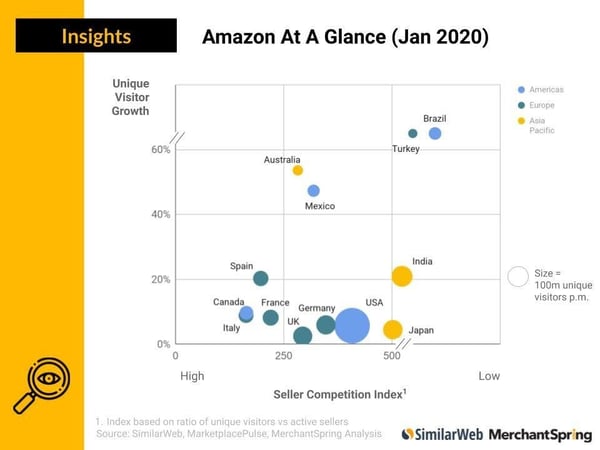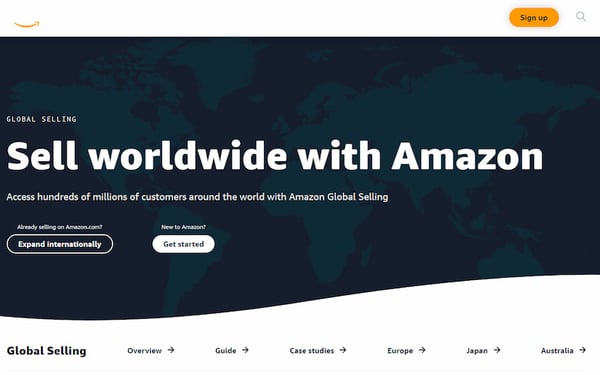Becoming an international Amazon seller is a fantastic way to diversify and grow your ecommerce business. The problem is, successfully navigating your way around all of Amazon’s red tape can be a massive time suck.
Formulating a plan before you embark on the journey is an absolute must. In this blog post we’ve explained how to appraise different marketplaces, international selling requirements and useful tools which can expedite the launch process.
We’ve also outlined the core steps of Bobsled’s launch plan. Read on!

How do I decide which countries to expand to first?
Here are some ideas about how to prioritize new Amazon marketplaces:
- Existing brand presence. Going into markets where your brand is already known and loved makes a lot of sense.
- GDP. How much disposable income is floating around in a target market? GDP could help immediately eliminate certain potential target regions.
- Language. Target markets that share a language with a source market don’t require translation costs, so will likely end up being more profitable.
- Start-up costs. Certain markets may require more approvals, documentation, tax compliance, packaging updates etc, hurting channel profitability.
Amazon US is the biggest market in terms of total traffic and revenue generated. Ballpark aggregates of other markets compared to the US are as follows:
- Canada is around 5-10% of total US sales volume.
- The UK is approximately 10% of total US sales volume.
- The EU (France, Italy, Germany, Netherlands and Spain combined) is also around 10% of total US sales volume.
- Australia is approximately 1% of total US sales volume.
Established markets such as Amazon US are incredibly saturated and have higher CPCs, but winning brands can generate enormous amounts of revenue due to the size and sophistication of the platform.
At the other end of the spectrum, newer marketplaces such as Amazon Australia are way less crowded and have far more affordable CPCs, but brands need to be realistic about the amount of revenue they can generate due to the burgeoning nature of the platform.

Above: This useful chart from Similar Web / Merchant Spring illustrates how different Amazon marketplaces compare in terms of visitor growth vs seller competition.
What are Amazon’s international selling requirements?
Amazon has ‘unified accounts’ for North American (US, Canada, and Mexico) and Europe (UK, Germany, France, Italy, Netherlands and Spain). If you already sell in one country within a unified region, you can expand to other markets in that region without opening a separate account.
Here are the high-level requirements for some of the most popular regions:
North America (US, Canada & Mexico)
To be eligible to sell on Amazon North America you need:
- To be resident in one of these countries.
- A valid bank account (it doesn’t have to be a North American bank account).
- A valid phone number.
- An internationally chargeable credit card.
Europe (UK, Germany, Italy, Spain, Netherlands & France)
To be eligible to sell on Amazon Europe you need:
- A bank account in one of these countries.
- A valid phone number.
- An internationally chargeable credit card.
Japan
To be eligible to sell on Amazon Japan you need:
- A bank account in Japan or the US.
- A valid phone number.
- An internationally chargeable credit card.
Australia
To be eligible to sell on Amazon Australia you need:
- Business name, address and contact information
- An internationally chargeable credit card.
- Phone number
- Tax identity information
💡 Bobsled can help assess the Amazon International opportunity
for your brand, learn more about our Account Launch service.
What is Amazon Global Selling?
Amazon Global Selling allows brands to list and sell their products on Amazon marketplaces in Europe, Asia-Pacific, the Middle East and the Americas.
The idea is that sellers save time and effort by managing offers in one marketplace. However, the program does not guarantee the creation of new product detail pages in targeted marketplaces. There are other synchronization challenges with Amazon Global relating to inventory, pricing and selling regulations. Therefore in some instances, sellers may prefer to sell across multiple marketplaces without unifying different accounts under Amazon Global Selling.

Above: Screenshot from sell.amazon.com/global-selling
Anyone with an Amazon seller account can enroll in Amazon Global Selling, but they must register a new selling account for each marketplace they want to expand into. For example, a US-based seller who wants to expand into Australia will have to create an Amazon.com.au seller account.
The exceptions are the unified accounts for North America (US, Canada, and Mexico) and Europe (UK, Germany, France, Italy, Netherlands and Spain). For example, if a US-based seller wants to expand to Canada via Amazon Global, they can use their existing US Amazon account and do not need to register separately.
In summary, Amazon Global Selling is a centralized dashboard where brands can manage international offers from a single place.
💡 Check out a Bobsled Home & Garden Amazon
International Launch Case Study
What is the Build International Listings (BIL) tool?
The Build International Listings (BIL) tool helps brands develop and create offers in a “source” marketplace and expand these offers out to “target” marketplaces.
For some sellers, this can make managing offers across multiple marketplaces easy. When you manipulate a product listing in the source account, target marketplaces are automatically updated. But unfortunately, the BIL tool doesn’t always work properly. There are often issues with listing and pricing updates appearing correctly.
If you intend to sell the same products across multiple marketplaces it may be worthwhile experimenting with BIL for a single ASIN. If it works seamlessly, go ahead and use BIL for more products. But if you run into headaches, you may be better off managing each account independently without connecting them via Amazon Global Selling.
New Amazon Account Launch Plan
Bobsled has launched thousands of new products on international marketplaces across every product category.

“International expansion is a logical next step for many brands selling on Amazon, but it’s an arduous process with many logistical hurdles,” explains Bobsled CEO Kiri Masters.
“The most important thing is to actually formulate a plan with concrete goals. Brands that launch internationally without a predetermined idea of what they’re intending to achieve are bound to be disappointed.”
Bobsled’s launch program has two distinct phases: pre-launch (everything that happens before products become active on the new marketplace) and channel management (everything that happens once the new products are live).
Find a broad overview of each step below:
Pre-Launch
- Market Research. Estimate the opportunity of each potential marketplace. Decide upon the target marketplaces, and which products to start with.
- Compliance. Investigate all the tax and VAT ramifications of selling in the target marketplaces. Make a decision about where to store inventory, and set up a process to register and file tax returns correctly.
- Account Set Up. Create accounts in all of the target marketplaces. Complete keyword research and develop product listings – everything needs to be translated to the local language.
- Inventory Prep. Complete sales velocity estimates, decide how much inventory to allocate for your first shipment. Update packaging where appropriate (e.g. translate warning labels or instruction manuals to the target marketplaces’ native languages).
- Shipment. Identify the safest and most cost-effective way to ship inventory to the target marketplace. Consider partnering with freight, customs and 3PL inventory specialists who can simplify and speed up the process.

✅ For more detailed info check out our Amazon Pre Launch Checklist
Channel Management
- Operations. Maintain excellent seller account metrics. Keep track of sales velocity, send inventory replenishments to ensure your products remain in-stock. Comply with all ongoing tax obligations.
- Brand Protection. Monitor your Amazon presence for unauthorized or counterfeit products. Maintain control of the buy box for your branded items.
- Customer Service. Respond to customer inquiries in accordance with Amazon’s seller guidelines. All customer messaging must be delivered in the market’s local language.
- Organic Marketing. Ensure the back and front-end of your product listings are optimized to rank on the search results page and convert traffic.
- Paid Advertising. Utilize the PPC options within your Amazon Advertising dashboard and the programmatic options within Amazon Demand-Side Platform (DSP) to augment growth. Use advertising performance (alongside organic sales results) to inform future product launch decisions.
.png)

